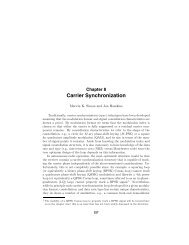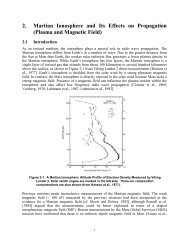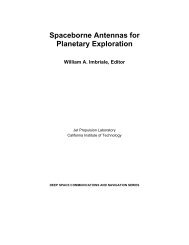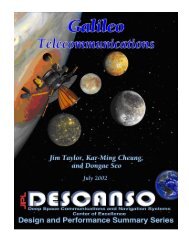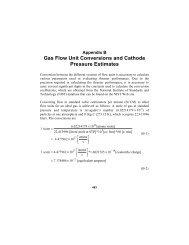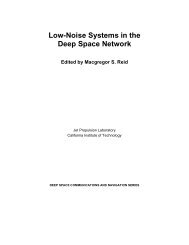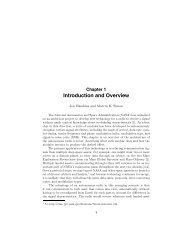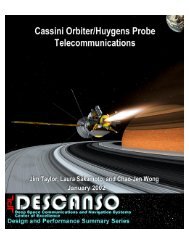Propagation Effects Handbook for Satellite Systems - DESCANSO ...
Propagation Effects Handbook for Satellite Systems - DESCANSO ...
Propagation Effects Handbook for Satellite Systems - DESCANSO ...
Create successful ePaper yourself
Turn your PDF publications into a flip-book with our unique Google optimized e-Paper software.
. .<br />
6.5.5.2.2 Spatial Diversity. Paths operating at very low elevation<br />
angles with narrow beamwidth antennas may experience unacceptable<br />
fading due to scintillation and multipath effects. The required<br />
reliability may be regained by the use of spaced site diversity. A<br />
site separation greater than 300 m transverse to the propagation<br />
path has been suggested (CCIR-1986b, Rpt 564-3) as necessary to<br />
alleviate severe turbulence-induced effects. In effect, separation<br />
on the order of or larger than the scale size of the largest<br />
inhomogeneities in refractive index along the propagation path, and<br />
especially near the surface where refraction is greatest~ results in<br />
decorrelation of the instantaneous signal fluctuations and hence<br />
improved per<strong>for</strong>mance.<br />
The aperture effects of large antennas may be circumvented if<br />
several phase-locked antennas, each with relatively wide beamwidthl<br />
are employed in an array to achieve the desired system gain. Of<br />
course, overall fade margins will be on the order of that <strong>for</strong> a<br />
single element, but angle-of-arrival effects are eliminated. In<br />
addition, such an array alleviates the need to mechanically track a<br />
geosynchronous satellite, as is necessary with large aperture,<br />
narrow beamwidth antennas.<br />
6.5.6 A Sample Computation of Siqnal Fluctuations and Gain<br />
Degradation<br />
In this section examples of the parameters described in Section<br />
6.5 are worked out <strong>for</strong> a hypothetical ground station located at<br />
Columbus, Ohio with a 4.6m (15 ft) diameter parabolic antenna<br />
observing a 28.56 GHz COMSTAR beacon at 10 degrees elevation angle.<br />
Actually, the COMSTAR satellites are not at that low an angle, but<br />
in order to demonstrate the effects of gain reduction this value has<br />
been arbitrarily selected.<br />
6.5.6.1 Amplitude Fluctuations. The variance of the received<br />
signal amplitude is calculated using the expression in Section<br />
6.5.2.2. The full half-power beamwidth<br />
c/fda = (70)(3x108m/see)/(28.56x10gsec -<br />
B in degrees is 70A /da = 70<br />
1) (4.6m) = 0.16 degrees. The<br />
6-101





